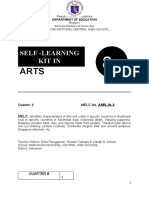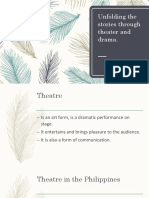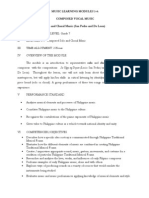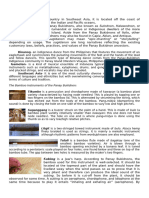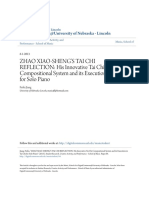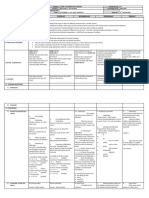Traditional Musical Instrument From Regions of Indonesia
Traditional Musical Instrument From Regions of Indonesia
Uploaded by
Susan PascualCopyright:
Available Formats
Traditional Musical Instrument From Regions of Indonesia
Traditional Musical Instrument From Regions of Indonesia
Uploaded by
Susan PascualCopyright
Available Formats
Share this document
Did you find this document useful?
Is this content inappropriate?
Copyright:
Available Formats
Traditional Musical Instrument From Regions of Indonesia
Traditional Musical Instrument From Regions of Indonesia
Uploaded by
Susan PascualCopyright:
Available Formats
Traditional Musical Instrument of Indonesia
1. KOLINTANG
The picture is traditional musical instrument from Minahasa
Kolintang or kulintang is a typical musical instrument Minahasa, North Sulawesi. Kolintang is made of
local leightweight wood but it is strong like an egg, bandaran, detention, wood kakinik chrysolite, and
having a parallel fiber construction.
Kolintang name comes from her voice: Tong (low tone), ting (high tone) and pliers (normal tone). In the
local language, call "Let's do TONG TANG Ting" is: "Mangemo kumolintang". Call it eventually turned into
kolintang said.
2. ANGKLUNG
The picture is traditional musical instrument from West Java
Angklung is the traditional Indonesian musical instrument coming from the Sundanese Land bang, made
from bamboo, read out by means of being shaken (the sound was caused by the collision of the body of
the bamboo pipe) so as to produce the sound shaking in the tone composition 2, 3, to 4 tones in each
measurement, both big and small. The harmony (the tone) the musical instrument angklung as
Sundanese tradition music most are salendro and pelog.
Angklung was created and played to attract Dewi Sri descended to Earth so that the crop of the people's
rice grows fertile. The function angklung as blowerthe spirit of the people is still continuing to be felt to the
colonisation period, that was the reason the Dutch East Indies government could ban the community
used angklung, the banning could make the popularity angklung descended and only in played by the
child- the child at that time. In his development, angklung developed and spread to all of Java, then to
Kalimantan and Sumatra. In 1908 was recorded by a cultural mission from Indonesia to Thailand,
including being marked by the surrender angklung, then the game of this bamboo music could then
spread there.)
3. GAMELAN
The picture is traditional musical instrument from Java or Bali.
Gamelan is ensembles music which is usually highlight metallophone, gambang, gendang, and gong.
Term gamelan refers instrument / appliance, whichever represent one unity intact actualized and rung
joint. Words Gamelan itself comes from Javanese language gamel meaning hitting / beating, followed
suffix Years which makes noun. Orches gamelan mostly exists there in Java, Madura, Bali and Lombok in
Indonesia in various types sizes and shapes ensembles. In Bali and Lombok currently, and Java passing
century 18, term gong more deemed synonym with gamelan.
4. SERULING
The picture is traditional musical instrument from Central Java
The flute is a kind of musical instrument that is blown. It is made of bamboo. However currently the flute
moden there are those that was made than aluminium metal and plastic. The method of playing him was
with blew. But the method blew the flute would true for dismissed the good sound
5. KENDANG
The picture is traditional musical from Central Java
Kendang is an instrument in the Central Java. Gamelan is one of the main functions set the
rhythm. This instrument is rung by hand, without helping tools. A kind of small drum is called
ketipung, the medium is called drum ciblon / Chebar. Ketipung couples have a name drum gedhe
Kalih commonly called drums. The functions of kendang are signaling some of the transitions
(paralihan) to sections and the end of the piece (suwuk). In dance orwayang, the kendhang player
must follow the movements of the dancer, and communicate them to the other players in the
ensemble. In West Java, kendang are used to keep the tempo of Gamelan Degung. Kendang are
also used as main instrument for Jaipongan dance. In another composition called Rampak
Kendang, (a group of drummers play in harmony.
Mostly drum gamelan is played by professional players, who have long dive into Javanese
culture. Most played drums in accordance players instincts, so when it is played by other person
it will be different.
Thailand Musical Instruments
There are many different varieties of Instruments from Thailand. They have 3 families of instruments, the
wind, percussion, and string instruments. There are 2 main types of string instruments, plucked and
bowed. The Percussion family is separated into 3 main groups, the drums, keyboards, and gongs or
cymbals. Also, many Thai instruments are very similar, just in different sizes to produce higher or lower
pitches.
The Ranat Ek
The Ranat Ek has a similar look to xylophones. The keys from the ranad ek do not touch the base of the
instrument, but rather hang over it, similar to a suspension bridge. The keys are wooden, and are different
sizes in order to make different sounds.
Ranat Ek Lek
The Ranat Ek Lek is similar to the Ranat Ek, but is made with metal keys, instead of wooden ones. The
Flat metal keys are placed over a wooden resonater.
Ranat Thum Lek
The Ranak Thum Lek was created to have a lower tone then the Ranat Ek Lek. The only major difference
is that all of the keys are larger, giving it a lower tone.
GrajaBpI
The Grajabpi is a stringed instrument, similar to a lute. The strings are plucked, and it is used in Thai
Classical Music. It is made of jackfruit or teak wood, and has four strings. The Grajabpi is
believed to be one of the oldest Thai instruments.
Saw Duang
The Saw Duang is a string instrument that is played with a bow. The box of the saw duang is
made from either bamboo or hardwood, and the skin on the end of the sound chamber is often
made from snake skin. The strings are often made from silk.
Saw u
The Saw U is similar to the Saw Duang, but larger and produces a lower pitch. It has 2 strings, and can
produce 8 notes. The soundbox of the Saw U is made from a coconut shell with the open side covered
with cowskin. The silk strings of the Saw U are played with a bow.
Taphon
The Taphon is a percussion instrument that is often found in a percussion ensemble called a piphat. The
Taphon has two heads, and is shaped like a barrel. It is played with your hands, not with mallets. Many
taphons have designs woven into the middle of the barrel.
Thon-Rammana
The Thon-Rammana are hand drums that are played in a pair. The Rammana is a frame drum that gives a
higher pitch, while the Thon is a goblet drum that gives a lower pitch.
Khong wong lek
The khong wong lek is a unique instrument. It is comprised of 18 small gongs that are in a circle. It is
similar to the khong wong yai, but has a higher pitch.
Khlui
The Khlui is mostly made from bamboo, but is made from hardwood, and sometimes even plastic too.
The seven lower holes on the Khlui are where the fingers sit, covering and uncovering them in order to
change the note that comes out.
PI Nai
The pi nai has 6 holes, through which it can make varying sounds, and 22 pitches. The pi nai is a form of
oboe, and is classified under the Thai wind instrument catergory. The reed of the pi nai is made of Bai
tan, a form of palm leaf.
JakHe
Approximately 20cm high, and 140cm long, the Jakhe has two strings made from silk, and two
strings made from brass. In order to play this instrument, your left hand goes on the frets, to change the
pitching, while your right hand strikes the strings with a ivory plectrum tied to your index finger.
Malaysian Musical instruments
Harmonium
This instrument originates from Great Britain, and was
introduced to India where it established itself as a vital
part of Indian music ensembles.
Later adapted by the Malays for ghazal performances.
Rebab
The rebab is the most important bowed lute and is the
main melodic instrument in the mak yong and is used to
accompany the wayang kulit.
Angklung
A hand-held musical instrument made of bamboo,
originated from Java, perhaps during the Majapahit era.
One angklung produces one note, hence angklung is a
team performance.
Kompang
The kompang is played in a large kompang ensemble.
The percussion is played with an interlocking rythmic
pattern to accompany choral singing. Popularly used in
wedding ceremonies.
Gamelan
This is a set of brass percussion, performed like an
orchestra from the Majapahit era in the l0th century AD.
Seruling
The Malay flute is made of bamboo. Perhaps the most
original musical instrument, often used by the
indigenous tribes (earlier Malays or Proto-Malays' who
inhabit the jungles).
Nafiri
The nafiri is a kind of trumpet found only in
the nobat orchestras of Malaysia. It is related to a
similar instrument known as the naifr from the Middle
East.
Gambus
The Arabian Oud is the ancestor of lutes and guitar.
Used in zapin and ghazal.
Rebana
Hand-held drums made of taut goat skin, originated
from the Middle East. The name rebana may come from
the Arabic word rabbana.
Gong
Commonly found in Southeast Asia. This hanging
instrument looks like a big brass tray with a protruding
navel (boss) at its centre where it is struck.
Marwas
Marwas is struck using one hand, to accompany
the Zapin dance. Originates from the Middle East.
Serunai
Another wind instrument, made of wood with seven
holes on the upper part and one hole at the other end.
Often used in shadow play (wayang kulit)
performance, menora (in Kelantan) or in silat (martial
art).
Gendang
Malay drums of varying sizes, made of taut buffalo or
cow hides. The biggest drum used in the palace is
called gendang nobat. For a commoner, the biggest
drum is rebana ubi found in Kelantan.
Traditional Vietnamese musical instruments
Traditional Vietnamese musical instruments are the musical instruments used in the traditional
and classical musics of Vietnam. They include of string, wind, and percussion instruments,
used by both the Viet (Kinh) majority as well as the nation's ethnic minorities.
String Intruments
Dan Bau, monochord of Vietnam, Dan Bau is a Vietnamese monochord, a traditional one-string
musical instrument.
Dan Nhi
Dan Nhi,Vietnamese two-chord fiddle. With melodious sounds, Dan Nhi becomes indispensable
one in a traditional musical orchest.
Percussion instruments
Trong Com
Trong Com, a traditional cylindrical drum in Vietnam. "How joyful to have
a Trong Com; and it is an honour for those who can clap it skilfully, oohh
ah bong ah bong...", are beautiful lyrics and melody of a famous song
from Vietnamese folklore about Trong Com.
Dan Da
Lithophone or Dan Da. Lithophone or Dan Da is also known as a
percussion instrument made of stone. The name is applied to a specific
instrument made of resonant stones that produces a ringing sound when hit..
Trung
Trung - The traditional folk-musical instrument. As one of the most
popular folk-music instrument of ethnic minority groups in Viet
Wind Intruments
Sao Truc
Sao Truc (Vietnamese Bamboo Flute). Sao Truc, which is certainly
Vietnams most well-known wind instrument with arch-form blowing hole,
has long been attached to the cultural and spiritual life of Vietnamese
people.
The Klong put
The Klong put is the Xe Dang language name of a musical instrument of
the wind family, air driving-in branch. It is played by ethnic groups in Tay
Nguyen (Central Highlands) such as the Xe Dang, Bahnar, Gia Rai, Hre,
etc.
Musical Instrument of Myanmar ( Burma)
Flute
The flute (palwei) is a wind instrument which consists of a
hollow tube played by blowing through a hole at one end. There
are two kinds of Myanmar flutes, the khin palwei and the kyaw
palwei. The khin palwei is the more commonly played and it has
a vintage and a reed at the blowing end.
Royal Drum
The royal drum or sidaw was played on royal occasions,
auspicious gatherings, and for favourable portents in the
villages.
Conch Shell
A conch shell, locally called Khaju thin, is a natural
shell with a hollow that produces sound when blown.
The shell has grooves on the outside to allow a good
hold for the four fingers of the musician. When
blowing the shell with the lips, it should be closed
lightly, not tightly, so that the lips may be made to
vibrate.
rass Gong Circle ( Kyei Waing )
The brass gong circle or kyei waing as it is locally called,
has 18 or 19 brass gongs in a circle similar to the drum
circle. It is played to accompany the drum circle and the
hne. Its sound is more melodious than the sound of the
framed gongs (maun: saing). The player strikes the boss on
the gong with a mallet. Two mallets are used for the two
hands, and when required, the sound is dampened by the
free fingers.
In Siem Reap, Patrick Kersal also has plans to increase public access to Cambodias musical
heritage by opening a museum at the Golden Silk farm near Banteay Srey temple. We say in
French, if you are going to know where you are going to, you need to know where you are
coming from, he says.
Musical Instruments of Cambodia
Chapei Dang Weng
The chapei dang weng is a two-stringed long-necked guitar. One of its most famous players is
Kong Nay, who became blind as a result of smallpox at the age of four. With his raspy voice and
wit, he is known as the Ray Charles of Cambodia and has toured worldwide.
Ksa Diew
An ancient one-stringed instrument made from a long piece of wood and a hollowed-out gourd.
Players pluck the string while holding the gourd near to the heart in order for it to resonate. The
rare instrument is notoriously difficult to play, say musicians, and is thought to be more than
1,000 years old.
Pin
This Angkorian harp features in bas reliefs on ancient temples and has been rebuilt thanks to
the efforts of Patrick Kersal. A new generation of musicians has been taught to play the
instrument as part of the Sounds of Angkor troupe, formed by Cambodia Living Arts, with similar
harps found in Myanmar.
You might also like
- Ascendance of A Bookworm Part 5 Volume 3Document194 pagesAscendance of A Bookworm Part 5 Volume 3ricacastillaNo ratings yet
- Regional Achievement Test Mapeh 7Document90 pagesRegional Achievement Test Mapeh 7Julius BalansagNo ratings yet
- Southeast Asian MusicDocument5 pagesSoutheast Asian MusicPRINTDESK by Dan86% (22)
- Da Manual PDFDocument4 pagesDa Manual PDFJer SowNo ratings yet
- OCSA Student ApplicationDocument24 pagesOCSA Student ApplicationAngelo PizarroNo ratings yet
- Poems To Learn by Heart Teaching GuideDocument16 pagesPoems To Learn by Heart Teaching GuideDisney Hyperion100% (4)
- Travis (1959) Towards A New Concept of TonalityDocument29 pagesTravis (1959) Towards A New Concept of TonalityLógica Usb100% (2)
- Super HirapDocument9 pagesSuper HirapJessica Marie Borromeo DHumNo ratings yet
- Grade 8 Chapter 2 - The Music of East Asia ChinaDocument45 pagesGrade 8 Chapter 2 - The Music of East Asia ChinahanaleahlausNo ratings yet
- Music 1 Quarter Music of Southeast Asia Module 1 Music of Indonesia ObjectivesDocument7 pagesMusic 1 Quarter Music of Southeast Asia Module 1 Music of Indonesia ObjectivesKaren Jamito MadridejosNo ratings yet
- Classification of Musical Instruments From IndiaDocument1 pageClassification of Musical Instruments From IndiaKath AlmendrasNo ratings yet
- Music of JapanDocument49 pagesMusic of JapanMaryjane Joy Osorio QuiñanolaNo ratings yet
- ARTS SLK Week 2Document15 pagesARTS SLK Week 2JosephEljayGarridoNo ratings yet
- Quarter 3 South, Central, and West AsiaDocument11 pagesQuarter 3 South, Central, and West Asianova rhea garciaNo ratings yet
- MAPEH ModuleDocument3 pagesMAPEH ModuleRojake Fernandez50% (2)
- Music - Q1 - Week 1-4Document4 pagesMusic - Q1 - Week 1-4Marnelyn Bagnes100% (1)
- Music: Quarter 1 - Module 2Document22 pagesMusic: Quarter 1 - Module 2Y u c k.No ratings yet
- Lesson 1 - Instrumental Music of East Asia PDFDocument94 pagesLesson 1 - Instrumental Music of East Asia PDFSamantha Chloe PalouNo ratings yet
- MalayDocument10 pagesMalayjessicaNo ratings yet
- MAPEH 8 3RD PERIODICAL TEST 20pointsDocument7 pagesMAPEH 8 3RD PERIODICAL TEST 20pointsRijah VenzonNo ratings yet
- East Asian MusicDocument3 pagesEast Asian MusicRaymond Tindugan100% (1)
- Multiple Choices: Choose The Letter of The Correct Answer. Write Your Answer in The SpaceDocument2 pagesMultiple Choices: Choose The Letter of The Correct Answer. Write Your Answer in The SpaceHazel Ann Paz100% (1)
- Burung Kakatua (Bahasa Indonesia) The Cockatoo (English)Document5 pagesBurung Kakatua (Bahasa Indonesia) The Cockatoo (English)Allan Cesario AbadNo ratings yet
- Learning Activity Sheet: ExploreDocument3 pagesLearning Activity Sheet: ExploreSHERYL NOVA100% (2)
- Music of The Lowlands of Luzon 2: Secular Music With Spanish InfluenceDocument20 pagesMusic of The Lowlands of Luzon 2: Secular Music With Spanish InfluenceRiza Indelible SibullasNo ratings yet
- Q1-Music 8-Thailand & LaosDocument22 pagesQ1-Music 8-Thailand & LaosYbur Hermoso-MercurioNo ratings yet
- Summative Test 4th Quarter in Music 8Document3 pagesSummative Test 4th Quarter in Music 8Scythe50% (2)
- 3rd PT in MAPEH 8Document2 pages3rd PT in MAPEH 8Rovilyn DizonNo ratings yet
- Mapeh Scrapbook 2Document19 pagesMapeh Scrapbook 2iiClockWxrkzNo ratings yet
- Module 1:music of Luzon (Highlands and Lowlands)Document3 pagesModule 1:music of Luzon (Highlands and Lowlands)Karen Jamito Madridejos100% (1)
- Myanmar S Musical CultureDocument23 pagesMyanmar S Musical CultureMC AbuyuanNo ratings yet
- 3Q Music 7Document34 pages3Q Music 7Precious Yesha GumapiNo ratings yet
- Music: Quarter 2 - Module 2 Music of Japan China and KoreaDocument10 pagesMusic: Quarter 2 - Module 2 Music of Japan China and KoreaKateNo ratings yet
- Southeast Asia MusicDocument5 pagesSoutheast Asia MusicAnoNo ratings yet
- Asia Musical InstrumentsDocument11 pagesAsia Musical InstrumentsArlene NavarroNo ratings yet
- Music 8 2nd Quarter ExamDocument2 pagesMusic 8 2nd Quarter ExamMa. Sharona OgkingNo ratings yet
- Music 7 Music of Philippine Festival and Theatrical Form: Quarter 4-Week 6Document3 pagesMusic 7 Music of Philippine Festival and Theatrical Form: Quarter 4-Week 6Princess Diane BallesterosNo ratings yet
- Quiz Music of MindanaoDocument2 pagesQuiz Music of Mindanaojuaningabanes0% (1)
- Music Grade 8 Quarter 4 Wayang KulitDocument4 pagesMusic Grade 8 Quarter 4 Wayang KulitZaira CabusayNo ratings yet
- Quarter 3 Module 1-2: MapehDocument31 pagesQuarter 3 Module 1-2: MapehKian Patrick LibiranNo ratings yet
- G8 Music of ThailandDocument8 pagesG8 Music of Thailandkukuhpaige100% (2)
- Simplified Melc-Based Budget of Lessons in Mapeh 8 (Music)Document5 pagesSimplified Melc-Based Budget of Lessons in Mapeh 8 (Music)Tahud NhsNo ratings yet
- Q2-ARTS8-Wk3 (The Mood, Idea or Message - Artifacts of East Asia)Document26 pagesQ2-ARTS8-Wk3 (The Mood, Idea or Message - Artifacts of East Asia)Rhe TolentinoNo ratings yet
- Quarter 3 - Module 1: Indoor Recreational Activities: Learning Activity SheetDocument8 pagesQuarter 3 - Module 1: Indoor Recreational Activities: Learning Activity SheetJestine Manoto100% (1)
- Art 8 Worksheet No.1 2ND QDocument5 pagesArt 8 Worksheet No.1 2ND QGeraldine WilsonNo ratings yet
- MAPEH 8 Discussion1Document13 pagesMAPEH 8 Discussion1Margielane AcalNo ratings yet
- Arts and Crafts in IndonesiaDocument11 pagesArts and Crafts in IndonesiaElvira Maranan100% (1)
- Unfolding The Stories Through Theater and Drama Grade 7 Q4Document14 pagesUnfolding The Stories Through Theater and Drama Grade 7 Q4Emerson Biclar GolipardoNo ratings yet
- Music of KoreaDocument23 pagesMusic of KoreaAirah Novie TangonanNo ratings yet
- Quarter 1 - Module 6: Influences in The Making of A Craft or Artifact (Highlands and Lowlands)Document17 pagesQuarter 1 - Module 6: Influences in The Making of A Craft or Artifact (Highlands and Lowlands)dibose85630% (1)
- Week 1 Arts and Crafts of Lowland LuzonDocument9 pagesWeek 1 Arts and Crafts of Lowland LuzonJay Mark G. LimeNo ratings yet
- Learning Activity Sheet in Mapeh 8 (Arts) Third Quarter - Week 3 and 4 IDocument8 pagesLearning Activity Sheet in Mapeh 8 (Arts) Third Quarter - Week 3 and 4 IClarry GruyalNo ratings yet
- 2nd Periodical Test Music WITH TOSDocument5 pages2nd Periodical Test Music WITH TOSCLEOTILDE BRUCENo ratings yet
- Words To Review MAPEH-7-PrinzDocument3 pagesWords To Review MAPEH-7-PrinzBryan Berino GonzalesNo ratings yet
- East Asian Art: - China - Japan - KoreaDocument20 pagesEast Asian Art: - China - Japan - KoreaAprille Maye Corpuz Cayog100% (1)
- Mapeh 7 q1 Week 1 Music 1Document11 pagesMapeh 7 q1 Week 1 Music 1FrennyNo ratings yet
- Music: Quarter 2 - Module 2b East Asian MusicDocument19 pagesMusic: Quarter 2 - Module 2b East Asian MusicByron DizonNo ratings yet
- Quiz 8 Arts and Crafts in Southeast Asia 2Document12 pagesQuiz 8 Arts and Crafts in Southeast Asia 2Jeneva Rose PerezNo ratings yet
- Music Ensembles of Laos and VietnamDocument15 pagesMusic Ensembles of Laos and VietnamAngel Faith AndradaNo ratings yet
- Performance TaskDocument7 pagesPerformance TaskAlmerto RicoNo ratings yet
- Grade 8 MusicDocument17 pagesGrade 8 MusicIncognito TestNo ratings yet
- Arts 8 Quarter 3: Learning Activity SheetDocument24 pagesArts 8 Quarter 3: Learning Activity SheetMa. Seceza Elaine EscuadraNo ratings yet
- Music 8 Las Q4 1Document30 pagesMusic 8 Las Q4 1Nina Ricci RetritaNo ratings yet
- Grade 7 Module 3 - 4 (Q3 & Q4)Document16 pagesGrade 7 Module 3 - 4 (Q3 & Q4)mary cris medenilla78% (9)
- MUSIC AND ARTS HandoutsDocument5 pagesMUSIC AND ARTS Handoutscyrine joy simbanaganNo ratings yet
- SMR SEC Template 2016Document1 pageSMR SEC Template 2016Susan PascualNo ratings yet
- Accioni ReinvidicatoriaDocument81 pagesAccioni Reinvidicatoriadsay88100% (1)
- Cases From Article 1 - 18 Consti Law 1Document254 pagesCases From Article 1 - 18 Consti Law 1lazylawstudentNo ratings yet
- Answers To The BAR: Taxation 1994-2006 (Arranged by Topics)Document2 pagesAnswers To The BAR: Taxation 1994-2006 (Arranged by Topics)Susan PascualNo ratings yet
- Definitions and Doctrines in Political LawDocument25 pagesDefinitions and Doctrines in Political LawJem VadilNo ratings yet
- Canon 1, Rule 1.01Document7 pagesCanon 1, Rule 1.01Yoan Baclig BuenoNo ratings yet
- Application For Certificate of Tax ExemptionDocument3 pagesApplication For Certificate of Tax ExemptionSusan Pascual100% (2)
- Audit ManualDocument10 pagesAudit ManualSusan PascualNo ratings yet
- Joint Affidavit of Two Disinterested PersonsDocument1 pageJoint Affidavit of Two Disinterested PersonsSusan PascualNo ratings yet
- Beam and Beam VsDocument2 pagesBeam and Beam VsSusan PascualNo ratings yet
- Forensic MedicineDocument100 pagesForensic MedicineSusan PascualNo ratings yet
- Conflict of Laws Case Digest: HASEGAWA Vs KITAMURA 538 SCRA 26 (2007)Document13 pagesConflict of Laws Case Digest: HASEGAWA Vs KITAMURA 538 SCRA 26 (2007)Susan PascualNo ratings yet
- ArtDocument1 pageArtSusan PascualNo ratings yet
- Chinese Compositional SytleDocument111 pagesChinese Compositional SytleTim ChongNo ratings yet
- Broken ToyDocument3 pagesBroken ToyDiego Arista HidalgoNo ratings yet
- One and Two Ways TOSDocument9 pagesOne and Two Ways TOSJeffrey Pascual ArrocenaNo ratings yet
- Bad Day ChordsDocument10 pagesBad Day ChordsLouella Mae CoraldeNo ratings yet
- A. Music G8 Fourth QuarterDocument7 pagesA. Music G8 Fourth Quarterjason bernalNo ratings yet
- LyricsDocument4 pagesLyricsCINTIAKRISTINANo ratings yet
- AccordionDocument12 pagesAccordionDante SallicopNo ratings yet
- Nationalism and Indiginization in Philippine Contemporary Music An Acculturated Response To WesternizationDocument8 pagesNationalism and Indiginization in Philippine Contemporary Music An Acculturated Response To WesternizationMikeNo ratings yet
- Regional Literature in TranslationDocument5 pagesRegional Literature in Translationvkm_ctrNo ratings yet
- DBSK HugDocument7 pagesDBSK HugpeterNo ratings yet
- DLL - English 6 - Q2 - W4Document10 pagesDLL - English 6 - Q2 - W4Melanie DucalangNo ratings yet
- The Virtuoso Challenge 7 Exercises in 7 Days: LEARN MORE AT Tonebase - CoDocument20 pagesThe Virtuoso Challenge 7 Exercises in 7 Days: LEARN MORE AT Tonebase - CoSamuele Biasibetti100% (4)
- Tedim Baptist Church - Yangon: No. 156, Baho Road, Sanchaung TownshipDocument1 pageTedim Baptist Church - Yangon: No. 156, Baho Road, Sanchaung TownshipHtaung Za KyintNo ratings yet
- TAB【Digimon Adventure Tri】-【Butterfly!】MusicGDocument3 pagesTAB【Digimon Adventure Tri】-【Butterfly!】MusicGAndika GhifariNo ratings yet
- Rappel: Infinitif To Be Infinitif ÊtreDocument5 pagesRappel: Infinitif To Be Infinitif ÊtreVWAZNo ratings yet
- Bass Triads Exercise PDFDocument1 pageBass Triads Exercise PDFMark Cox100% (2)
- Alphabet With PicturesDocument9 pagesAlphabet With PicturesAlexandra ValentinovnaNo ratings yet
- Wanted Dead or Alive ChordsDocument2 pagesWanted Dead or Alive ChordsTomer MizrahiNo ratings yet
- Phrases and Clauses - Class 8 - WorksheetDocument2 pagesPhrases and Clauses - Class 8 - WorksheetSamarveer Singh PathaniaNo ratings yet
- A Little Respect - ChordsDocument2 pagesA Little Respect - ChordsThiago AntoniettoNo ratings yet
- How Far Ill GoDocument3 pagesHow Far Ill GocyrilNo ratings yet
- Taylor Swift - But Daddy I Love Him Lyrics Genius LyricsDocument1 pageTaylor Swift - But Daddy I Love Him Lyrics Genius LyricsmarysiaplcomNo ratings yet
- You Are Not AloneDocument6 pagesYou Are Not AloneÁngel SantosNo ratings yet
- Gillis - Sound Concepts For SaxDocument4 pagesGillis - Sound Concepts For SaxBrianna WilliamsNo ratings yet
- Chapter 11 Fine ArtsDocument17 pagesChapter 11 Fine ArtsakashNo ratings yet












